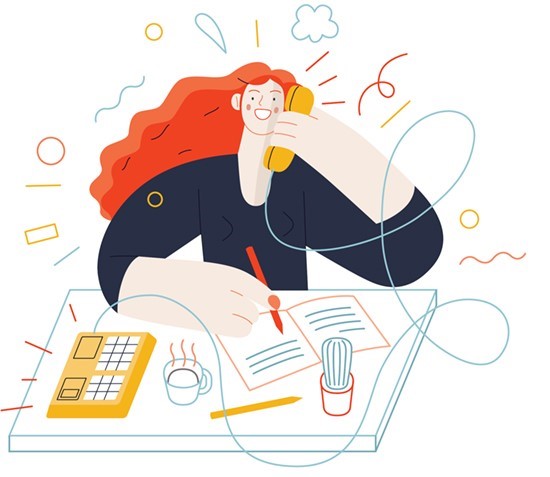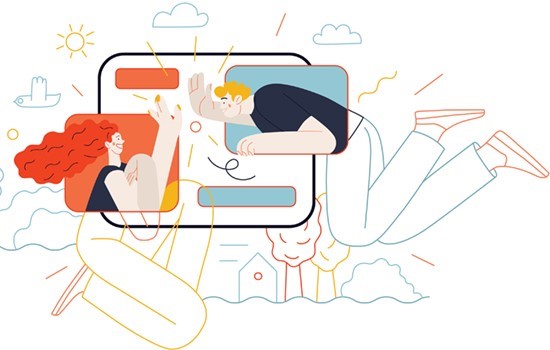There has been an uprising in an art style that overtook various well-known
popular websites like
Google,
Duolingo, and
Facebook. The art style is called
corporate art, also known as “Corporate Memphis”, and was developed for
Facebook in 2017 by the design company Buck, created by artist Xoana Herrera.
While the art style has an official name, Facebook adopted the name Alegria, as
its alias, which means “joy” in Spanish.
اضافة اعلان
The original intent of
Alegria was to be universally
accessible, visually appealing, and relatable. A variety of skin tones, a
streamlined, simplified design, motion-filled animations, and occasionally
exaggerated anatomical characteristics are used to show off people’s diversity.
The artwork in this vector-style art is
characterized by flat colors, little to no shading, and an overabundance of
geometric shapes. The purpose of Corporate Memphis is to “draw your attention
as you scroll around the website’s user interface”, Mohammad Souqi, a senior
UI/UX designer working for EON Dental, remarks.
“It triggers associations in your mind that will
eventually cause you to think, ‘Oh! That must be Facebook,’ when you see this
artwork utilized elsewhere.”

As a result, the revenue of the aforementioned
website rises thanks to the deliberate yet subtle psychological games employed
by numerous Big Tech corporations.
Yet, the attempt somewhat failed, as viewers began
to complain that the unlikeable characters were becoming more grating to watch
than entertaining. In recent years, criticism has gained even more traction.
“I have hated this style for as long as I can
remember,” a commentator said under the YouTube video “Why do ‘Corporate Art
Styles’ feel fake?” by Solar Sands, which garnered over 4 million views.
“This art style has to be the most off-putting,
malign style ever invented,” chimed another, “it feels like it drains the soul
out of everything it depicts.”
To be inclusive, the characters created have blue
skin and beady eyes that no one can identify with, leaving onlookers feeling
uneasy. This led to many individuals feeling that this artistic movement was
inauthentic, which ironically mirrors what people complained about the original
Memphis Group in the 1980s.
Similar to the present backlash against Alegria,
this group’s post-modern work was derided and despised by many for having
dystopian elements.
‘Too
colorful, it hurts the eyes and spirit.’
What sets the characters in this art style apart is the
use of gangly arms and noodle-like legs, all of which give off an unearthly
charm that confuses and puts off the viewer. Its minimalism was criticized by
many parents as well, who proclaimed that “their kid can draw better than
whatever those things are”.
In keeping with its name, Alegria, many individuals
believe the art form to be somewhat “obnoxiously joyful”, relating to its
supposed childish nature. The sum of all of this has been described as
“insulting” to adults, who feel like they have been infantilized by the use of
this style.

“The animations have even previously caused visual
fatigue to many of its viewers, which was interesting to learn about,” says
Gregor, a user in a graphic-design discussion forum.
“Our company, of course, has worked to reduce the
motion in which these animations move, after receiving these complaints. But
not many companies are willing to change or adapt like that.”
Despite the large amount of criticism, there are
still people who like it, and are in favor of it being used.
Big Tech companies have been known to severely
underpay their workers, according to research done by Paysa on salary
databases. Especially when it comes to art, many of these companies may
undervalue their artists and illustrators despite their great efforts to
produce high-quality images.
In contrast, Corporate Memphis has art that is
easily editable, detachable, removable, and changeable with a click of a
button. Considering that most of those images do not overlap, it is easier to
rearrange them to represent a specific message.
“Not only is it easier to fumble with, but it is
easily reproducible by different artists as it does not require a personal art
style or quirk,” said Al-Wadeya Jasmin, a Belarusian Printing Centre graphic
designer.

“It is hard to maintain a specific brand when the
illustrators all have different styles. This makes everyone’s job easier. This
style is based on simple, geometric shapes, anyone is capable of editing
those.”
While many people may dislike Corporate Memphis, or
heavily criticize its existence, it serves a purpose in the Big Tech world,
whether because of its lower costs or the easiness with which it can be used.
Souqi said: “These illustrations can make the app or
website more user-friendly by explaining complex ideas in simple visuals,”
which is what tech companies have been on the lookout for in the past decade.
Read more Lifestyle
Jordan News



